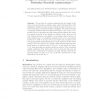Free Online Productivity Tools
i2Speak
i2Symbol
i2OCR
iTex2Img
iWeb2Print
iWeb2Shot
i2Type
iPdf2Split
iPdf2Merge
i2Bopomofo
i2Arabic
i2Style
i2Image
i2PDF
iLatex2Rtf
Sci2ools
SIROCCO
2007
2007
Design of Minimal Fault Tolerant On-Board Networks: Practical Constructions
Abstract. The problem we consider originates from the design of efficient on-board networks in satellites (also called Traveling Wave Tube Amplifiers). Signals incoming in the network through ports have to be routed through an on-board network to amplifiers. The network is made of expensive switches with four links and subject to two types of constraints. First, the amplifiers may fail during satellite lifetime and cannot be repaired. Secondly, as the satellite is rotating, all the ports are not well oriented and hence not available. Let us assume that we have p + λ ports (inputs) and p + k amplifiers (outputs), then a (p, λ, k)−network is said to be valid if, for any choice of p inputs and p outputs, there exist p edge-disjoint paths linking all the chosen inputs to all the chosen outputs. Then, the objective is to design a valid network having the minimum number of switches denoted N(p, λ, k). In the special case where λ = 0, these networks were already studied as selectors...
| Added | 30 Oct 2010 |
| Updated | 30 Oct 2010 |
| Type | Conference |
| Year | 2007 |
| Where | SIROCCO |
| Authors | Jean-Claude Bermond, Frédéric Giroire, Stéphane Pérennes |
Comments (0)

